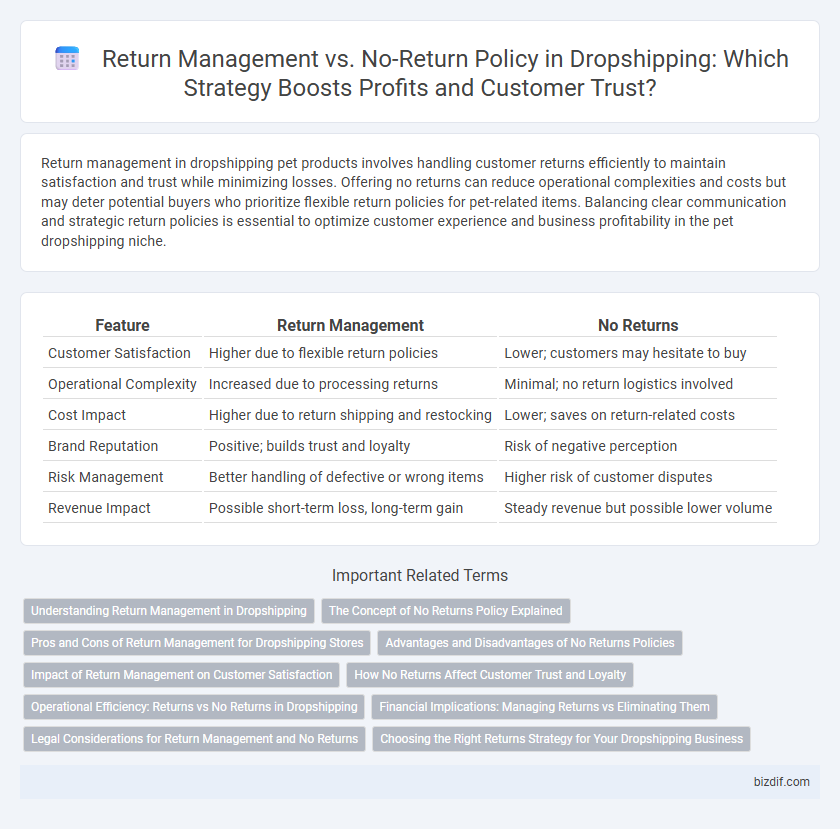Return management in dropshipping pet products involves handling customer returns efficiently to maintain satisfaction and trust while minimizing losses. Offering no returns can reduce operational complexities and costs but may deter potential buyers who prioritize flexible return policies for pet-related items. Balancing clear communication and strategic return policies is essential to optimize customer experience and business profitability in the pet dropshipping niche.
Table of Comparison
| Feature | Return Management | No Returns |
|---|---|---|
| Customer Satisfaction | Higher due to flexible return policies | Lower; customers may hesitate to buy |
| Operational Complexity | Increased due to processing returns | Minimal; no return logistics involved |
| Cost Impact | Higher due to return shipping and restocking | Lower; saves on return-related costs |
| Brand Reputation | Positive; builds trust and loyalty | Risk of negative perception |
| Risk Management | Better handling of defective or wrong items | Higher risk of customer disputes |
| Revenue Impact | Possible short-term loss, long-term gain | Steady revenue but possible lower volume |
Understanding Return Management in Dropshipping
Return management in dropshipping involves handling customer returns efficiently to maintain trust and reduce losses while complying with supplier policies. Effective return management strategies include clear return policies, automated tracking systems, and coordination with suppliers to process refunds or exchanges promptly. Neglecting return management can lead to increased customer dissatisfaction, negative reviews, and potential account suspension on selling platforms.
The Concept of No Returns Policy Explained
A no returns policy in dropshipping means customers cannot send back products after purchase, reducing logistical costs and simplifying inventory management for sellers. This approach minimizes disputes and processing time, but requires clear communication of product details and quality assurances to maintain customer trust. Effective no returns policies rely on precise product descriptions, reliable suppliers, and robust customer service to mitigate potential dissatisfaction.
Pros and Cons of Return Management for Dropshipping Stores
Return management in dropshipping offers enhanced customer satisfaction by enabling hassle-free product exchanges and refunds, which can build trust and encourage repeat purchases. However, it increases operational complexity and costs, including shipping fees and handling time, potentially reducing profit margins. Balancing efficient return policies with cost control is crucial for sustainable dropshipping store growth.
Advantages and Disadvantages of No Returns Policies
No returns policies simplify dropshipping operations by reducing processing costs and minimizing disputes, which enhances seller efficiency and profitability. However, this approach can negatively impact customer trust and satisfaction, leading to decreased repeat business and higher refund-related complaints. Balancing the reduction of logistical complexities with maintaining positive customer relationships is crucial for sustainable dropshipping success.
Impact of Return Management on Customer Satisfaction
Effective return management in dropshipping significantly enhances customer satisfaction by providing buyers with confidence and trust in the purchasing process. Offering clear, hassle-free return policies reduces buyer hesitation, leading to increased repeat business and positive reviews. Conversely, a no-returns policy may deter potential customers and harm brand reputation, resulting in lower conversion rates and diminished long-term profitability.
How No Returns Affect Customer Trust and Loyalty
Implementing a no returns policy in dropshipping often diminishes customer trust by creating uncertainty about product quality and satisfaction guarantees. Customers tend to prefer retailers who offer hassle-free returns, which reinforces loyalty through perceived reliability and customer-centric service. Without return options, negative experiences accumulate, ultimately reducing repeat purchases and damaging brand reputation.
Operational Efficiency: Returns vs No Returns in Dropshipping
Return management in dropshipping often requires robust systems for tracking, processing refunds, and coordinating with suppliers, which can increase operational complexity and costs. A no-returns policy streamlines order processing and inventory management, significantly reducing time spent on customer service and logistics. Efficient operational workflows are critical for maintaining profitability and scalability in dropshipping businesses, where minimizing return-related disruptions enhances overall performance.
Financial Implications: Managing Returns vs Eliminating Them
Return management in dropshipping involves handling costs such as reverse logistics, restocking fees, and potential lost revenue from returned items, which can significantly impact profit margins. Eliminating returns reduces operational expenses and simplifies cash flow, but it may also increase customer dissatisfaction and decrease repeat purchases. Balancing return policies with financial implications requires assessing the trade-off between cost savings and customer retention in the dropshipping business model.
Legal Considerations for Return Management and No Returns
Return management in dropshipping requires strict adherence to consumer protection laws, including clear return policies that comply with regulations like the Consumer Rights Directive in the EU or the FTC guidelines in the US, ensuring transparency and minimizing legal risks. Implementing a no returns policy can lead to non-compliance issues and potential legal penalties, as many jurisdictions mandate a minimum return period for online purchases. Properly managing returns not only safeguards against regulatory sanctions but also enhances customer trust and brand reputation within the competitive dropshipping market.
Choosing the Right Returns Strategy for Your Dropshipping Business
Effective return management in dropshipping enhances customer trust and brand reputation by providing clear policies and streamlined processes, which can reduce refund rates and operational costs. Opting for a no-returns policy may simplify logistics and minimize expenses but risks alienating customers and limiting repeat business. Selecting the right returns strategy depends on factors like product type, supplier agreements, customer expectations, and competitive landscape, ensuring a balance between customer satisfaction and profitability.
Return Management vs No Returns Infographic

 bizdif.com
bizdif.com